
The festival of San Fermín is a week-long, historically rooted celebration held annually in the city of Pamplona, Navarre, in Basque Country. The celebrations start at noon on 6 July and continue until midnight on 14 July. A firework (Chupinazo) starts off the celebrations and the popular song Pobre de mí is sung at the end. The most famous event is the running of the bulls, which begins at 8 a.m. each day on 7–14 July, but the festival involves many other traditional and folkloric events. It is known locally as Sanfermines and is held in honour of Saint Fermin, the co-patron of Navarre.

A running of the bulls is an event that involves running in front of a small group of bulls, typically six but sometimes ten or more, that have been let loose on sectioned-off streets in a town, usually as part of a summertime festival. Particular breeds of cattle may be favored, such as the toro bravo in Spain, also often used in post-run bullfighting, and Camargue cattle in Occitan France, which are not fought. Bulls are typically used in such events.
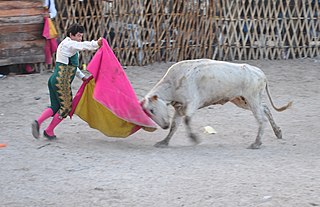
A bullfighter is a performer in the activity of bullfighting. Torero or toureiro, both from Latin taurarius, are the Spanish and Portuguese words for bullfighter and describe all the performers in the activity of bullfighting as practised in Spain, Portugal, Mexico, Peru, France, Colombia, Ecuador, Venezuela and other countries influenced by Portuguese and Spanish culture. The main performer and leader of the entourage in a bullfight, and who finally kills the bull, is addressed as maestro (master), or with the formal title matador de toros. The other bullfighters in the entourage are called subalternos and their suits are embroidered in silver as opposed to the matador's gold. They include the picadores, rejoneadores, and banderilleros.

The Sun Also Rises is the first novel by American writer Ernest Hemingway. It portrays American and British expatriates who travel along the Camino de Santiago from Paris to the Festival of San Fermín in Pamplona and watch the running of the bulls and the bullfights. An early modernist novel, it received mixed reviews upon publication. Hemingway biographer Jeffrey Meyers writes that it is now "recognized as Hemingway's greatest work" and Hemingway scholar Linda Wagner-Martin calls it his most important novel. The novel was published in the United States in October 1926 by Scribner's. A year later, Jonathan Cape published the novel in London under the title Fiesta. It remains in print.
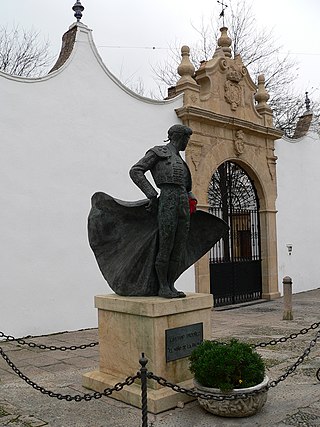
Cayetano Ordóñez y Aguilera is the patriarch of the Ordóñez family of bullfighters.

The Spanish Fighting Bull is an Iberian heterogeneous cattle population. It is exclusively bred free-range on extensive estates in Spain, Portugal, France and Latin American countries where bull fighting is organized. Fighting bulls are selected primarily for a certain combination of aggression, energy, strength and stamina. In order to preserve their natural traits, during breeding the bulls rarely encounter humans, and if so, never encounter them on foot.

Spanish-style bullfighting is a type of bullfighting that is practiced in Spain, Mexico, Colombia, Ecuador, Venezuela, Peru, as well as in parts of southern France and Portugal. This style of bullfighting involves a physical contest with humans attempting to publicly subdue, immobilize, or kill a bull. The most common bull used is the Spanish Fighting Bull, a type of cattle native to the Iberian Peninsula. This style of bullfighting is seen to be both a sport and performance art. The red colour of the cape is a matter of tradition – bulls are color blind. They attack moving objects; the brightly-colored cape is used to mask blood stains.

Antonio Cayetano Rivera Ordóñez is a Spanish torero or 'bullfighter'.

Alexander Rupert Fiske-Harrison is an English author, journalist, conservationist and bullfighter.
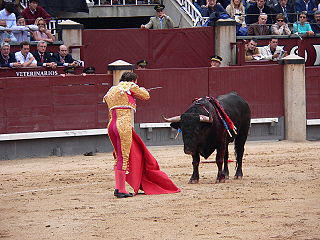
Bullfighting is a physical contest that involves a bullfighter attempting to subdue, immobilize, or kill a bull, usually according to a set of rules, guidelines, or cultural expectations.

Hotel La Perla is a five-star hotel in Pamplona, Spain and is located in the Plaza del Castillo, with one side facing Estafeta Street, one of the main routes in the Running of the Bulls. The balconies of the hotel are among the most coveted sites from which to view the event.
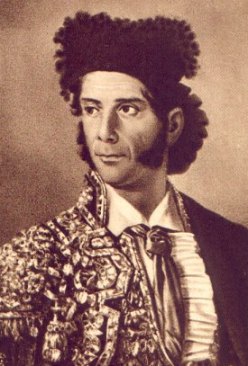
Museo Municipal Taurino Francisco Montes is located in Chiclana de la Frontera, in the province of Cádiz, Andalusia, southwestern Spain. Situated on San Agustín Street, the bullfighting museum is dedicated to the matador Francisco Montes Reina (1805–1851), nicknamed "Paquiro", who was born in this town. He is considered the most important 19th century bullfighter, because of his skill at the sport, on foot or on horseback. The bullfighting displays include pieces of great historical and artistic value. It was inaugurated in 2003 and founded by Pedro Leal Aragon who for seven years collected objects, souvenirs and bullfighting implements. One of its first events was a group show of the artists Antonio Vela, Carlos Quevedo, and Paloma Garcia. After a renovation, it re-opened in June 2005 with miniature models of the bullring in Ronda, a head bust of Paquiro, and an original painting by Antonio Cavanna.The expansion also housed Spain's most important bullfighting collection, Collection Sagnier, which was acquired by the city to improve the historical and artistic quality of the municipal bullfighting museum. There are four rooms: bullfighting origins, Paquiro and his time, contemporary bullfighting, and the bull and the arts. The museum's garden is used for book presentations, press conferences, weddings and small concerts. It is closed on Sundays.
Paco Cano Lorenza, also known as Canito, was a Spanish photojournalist from Valencia, who specialized in torero photography.

Juan José Padilla is a Spanish torero ('bullfighter'). He became a matador de toros, 'killer of (full-grown) bulls', in the town of his birth, Jerez de la Frontera, on June 18, 1994 when he was 21 years old. He was known as the 'Cyclone of Jerez' and featured heavily, both personally and professionally, in Into The Arena: The World Of The Spanish Bullfight, a shortlisted nominee for the William Hill Sports Book of the Year in 2011.
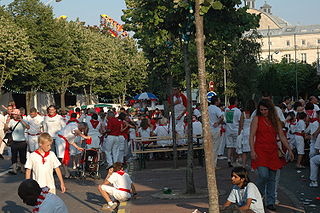
A feria is an annual local festival in Spain and southern France, characterized by bullfights, bull running in the streets, bodegas and bandas. The word festayre means ferias' partiers.

Ignacio Baleztena Ascárate (1887–1972) was a Spanish folk customs expert, a Carlist politician and soldier.
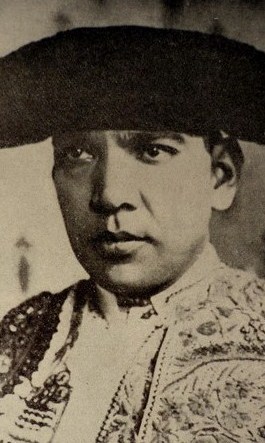
Rodolfo Gaona y Jiménez, was a Mexican bullfighter who performed from 1905 until his retirement in 1925, primarily in Madrid. Known as El Indio Grande and La Califa de León, Gaona was part of the Golden Age of bullfighting in Spain alongside Juan Belmonte and Joselito. He invented the gaonera and pase del centenario moves.
Juan José García Corral, was a Spanish bullfighter and director of the Escuela Tauromaquia of Salamanca
Pablo Lozano Martín, commonly known as La Muleta de Castilla, was a Spanish bullfighter and fighting bull cattle rancher, owner of cattle raising Alcurrucén and "Hermanos Lozano".
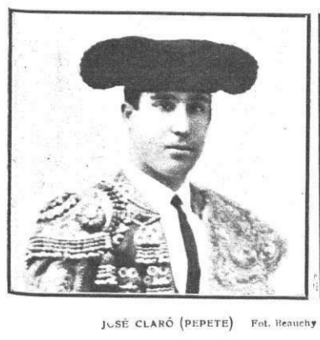
José Gallego Mateo, known as Pepete III, was a Spanish matador.

















